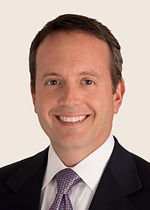 If there's one thing that Brent Saunders has experienced and engineered over the past few years, it's been radical change. The MBA has vaulted from Bausch & Lomb to Forest Labs and then on to the helm of a rapidly evolving Allergan ($AGN). And with Allergan now in amiable discussions for a megamerger with Pfizer ($PFE), the management team quarterback clearly has his sights set on the big prize: CEO of a greatly expanded pharma giant.
If there's one thing that Brent Saunders has experienced and engineered over the past few years, it's been radical change. The MBA has vaulted from Bausch & Lomb to Forest Labs and then on to the helm of a rapidly evolving Allergan ($AGN). And with Allergan now in amiable discussions for a megamerger with Pfizer ($PFE), the management team quarterback clearly has his sights set on the big prize: CEO of a greatly expanded pharma giant.
Bloomberg heated up speculation about a change at the top, reporting that Saunders is up for the CEO's job, with the 62-year-old Ian Read open to turning over the top job upon completing the massive tax inversion for Pfizer.
That's going to require some more change on Saunders' part, and you shouldn't be too surprised if a fresh challenge leads to an instant makeover when it comes to drug development strategies.
 |
| Allergan CEO Brent Saunders |
Saunders, of course, had delighted in underscoring Allergan's skepticism when it comes to early stage research and discovery.
"The best way for us to participate in discovery is investing in a more 'virtual' sense, than actually building and running our own labs," Saunders said in an interview with Reuters last summer. "Discovery is where the industry has its lowest return on investment," he said, "and not a good (use) of Allergan's research dollars."
But by last week, Saunders had no problem reassessing the role of discovery.
"I practice a very open minded management structure and learn new things all the time that change my opinion," Saunders said in an interview with Reuters last week. "For instance, when Actavis and Allergan merged, we didn't have any discovery capabilities, but we assessed Allergan's discovery capabilities in ophthalmology and aesthetic medicine and recognize they added a lot of value. Not only have we kept them; we've invested in them."
The debate over just who makes a good big pharma CEO has raged for decades. And the pros and cons over whether a scientist should be in charge has been weighed repeatedly.
It's not unusual for the CEO of a pharma giant to come in with little or no R&D experience. Read himself has a chemistry background, but made his rep running the emerging markets business as a longtime Pfizer insider. Pfizer, of course, went through a massive makeover of R&D, carving billions out of its research budget. The end result was a largely unimpressive pipeline--aside from the big Ibrance approval--and thousands of layoffs. About the same time as Read's promotion, Merck picked a lawyer to run the business, Ken Frazier, who later switched R&D chiefs and brought on Roger Perlmutter to help right a wayward research ship. Eli Lilly ($LLY) has a scientist in charge, John Lechleiter, but no big, game-changing blockbuster approvals to show for it. Andrew Witty at GSK came from marketing, and generally earns poor marks on both marketing and R&D. And Olivier Brandicourt at Sanofi has just learned how hard it is to get high grades on creative thinking.
So it's a mixed bag, with lots of criticism for Big Pharma innovation, or the general lack of it.
CEOs are responsible for all the numbers. If Saunders does get the CEO post at Pfizer postmerger, with an eye to a later split that leaves him in charge of the branded pharma arm, you can bet he'll be anxious to prove the company has a solid pipeline, with a renewed focus on late-stage assets.
That's likely to spur even more deals, and Saunders loves nothing more than buying and selling assets. -- John Carroll, editor-in-chief. (email | Twitter)